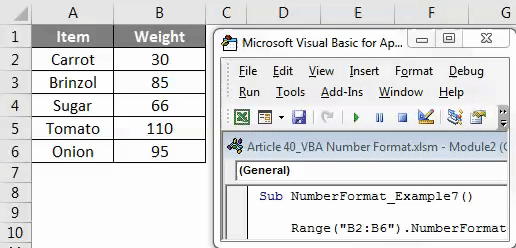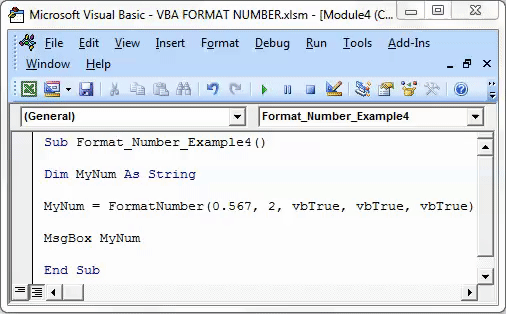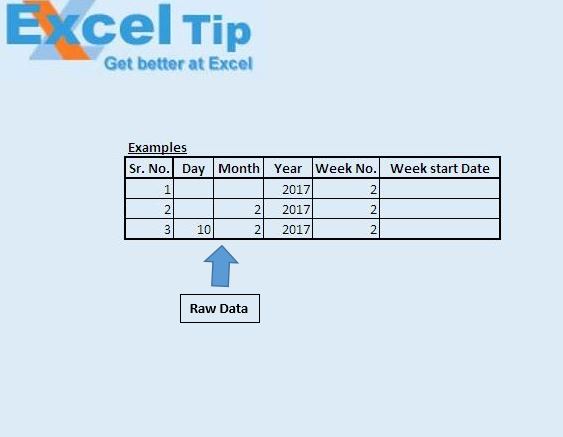

As long as you have the date stored, you can always compute the week number, in a query, form, or report.
#Vba week number iso
It will default to Thursday and, since we are using the ISO weeknumber system, should always fall within the current year. There is no need for an field in your table to store the week number. DOW is an optional argument representing the day of the week.Credits to these guys: Solution 3Īs an additional option, for those using the ISO weeknumber system, where Week 1 of the year is the first week of the year containing four days (or the week that includes the first Thursday of the calendar year, and the first day of the week is Sunday. You have to pass which day do you want as third parameter. It works quite ok, taking in mind that the first day of the week is Sunday: Function fnDateFromWeek(ByVal iYear As Integer, ByVal iWeek As Integer, ByVal iWeekDday As Integer)įnDateFromWeek = DateSerial(iYear, 1, ((iWeek - 1) * 7) + iWeekDday - Weekday(DateSerial(iYear, 1, 1)) + 1) GetDayFromWeekNumber = DateAdd("ww", WeekNumber - 1, DateSerial(InYear, 1, i)) 'Function will return if you don't use a good DayInWeek1Monday7Sundayĭo While Weekday(DateSerial(InYear, 1, i), vbMonday) DayInWeek1Monday7Sunday The TRUE and FALSE values are multiplied by amounts. Since weeks contains all 12 values, the result is an array with 12 TRUE and FALSE results. Inside the SUM function, this value is compared to weeks. "DayInWeek1Monday7Sunday!", vbOKOnly + vbCritical At each row, it applies this calculation: LAMBDA ( r, SUM (( weeks r) amounts)) The value for r is the week number in the 'current' row. MsgBox "Please input between 1 and 7 for the argument :" & vbCrLf & _ It has two arguments, the 1 st is required and the 2 nd is optional: WEEKNUM (serialnumber, returntype) Serialnumber - any date within the week whose number you are trying to find. Optional DayInWeek1Monday7Sunday As Integer = 1) As Date The WEEKNUM function is used in Excel to return the week number of a specific date in the year (a number between 1 and 54). Or use the below function GetDayFromWeekNumberĭebug.Print Format(GetDayFromWeekNumber(2017, 1, 4), "ddd d MMM yyyy")Īnd the generic function GetDayFromWeekNumber : Public Function GetDayFromWeekNumber(InYear As Integer, _

If others are looking into this and don't want a Thursday or don't work on 2017 : When comparing December 31 to January 1 of the immediately succeeding year, DateDiff for Year ("yyyy") returns 1 even though only a day has elapsed.For a specific year, you can do it like this : DateAdd("ww", WeekNumber - 1, DateSerial(2017, 1, 5))Īnd to test it : Debug.Print Format(DateAdd("ww", WeekNumber - 1, DateSerial(YearNumber, 1, 5)), "ddd d MMM yy")
#Vba week number code
This makes it possible to write code that can be used in different years. However, if date1 or date2 is enclosed in double quotation marks (" "), and you omit the year, the current year is inserted in your code each time the date1 or date2 expression is evaluated. If date1 or date2 is a date literal, the specified year becomes a permanent part of that date. The firstdayofweek argument affects calculations that use the "w" and "ww" interval symbols. If date1 refers to a later point in time than date2, the DateDiff function returns a negative number. DateDiff counts date2 if it falls on a Sunday but it doesn't count date1, even if it does fall on a Sunday. It counts the number of Sundays between date1 and date2. If interval is Week ("ww"), however, the DateDiff function returns the number of calendar weeks between the two dates. If date1 falls on a Monday, DateDiff counts the number of Mondays until date2. When interval is Weekday ("w"), DateDiff returns the number of weeks between the two dates. To calculate the number of days between date1 and date2, you can use either Day of year ("y") or Day ("d"). For example, you might use DateDiff to calculate the number of days between two dates, or the number of weeks between today and the end of the year. Use the DateDiff function to determine how many specified time intervals exist between two dates. Start with the first week that has at least four days in the new year. Start with week in which January 1 occurs (default). The firstweekofyear argument has these settings: Constant The firstdayofweek argument has these settings: Constant The interval argument has these settings: Setting If not specified, the first week is assumed to be the week in which January 1 occurs. A constant that specifies the first week of the year. A constant that specifies the first day of the week. Two dates you want to use in the calculation. String expression that is the interval of time you use to calculate the difference between date1 and date2.

The DateDiff function syntax has these named arguments: Part SyntaxĭateDiff( interval, date1, date2, ] ) Returns a Variant ( Long) specifying the number of time intervals between two specified dates.


 0 kommentar(er)
0 kommentar(er)
